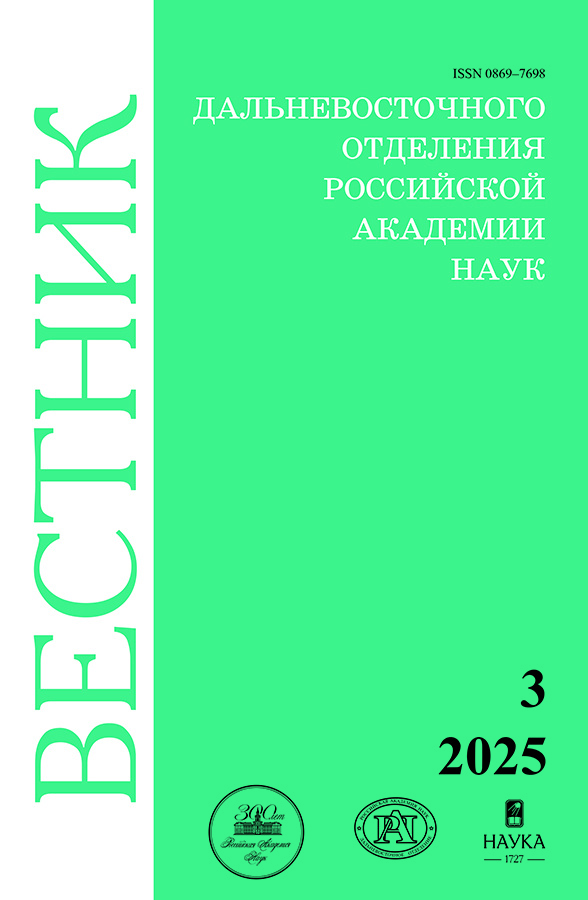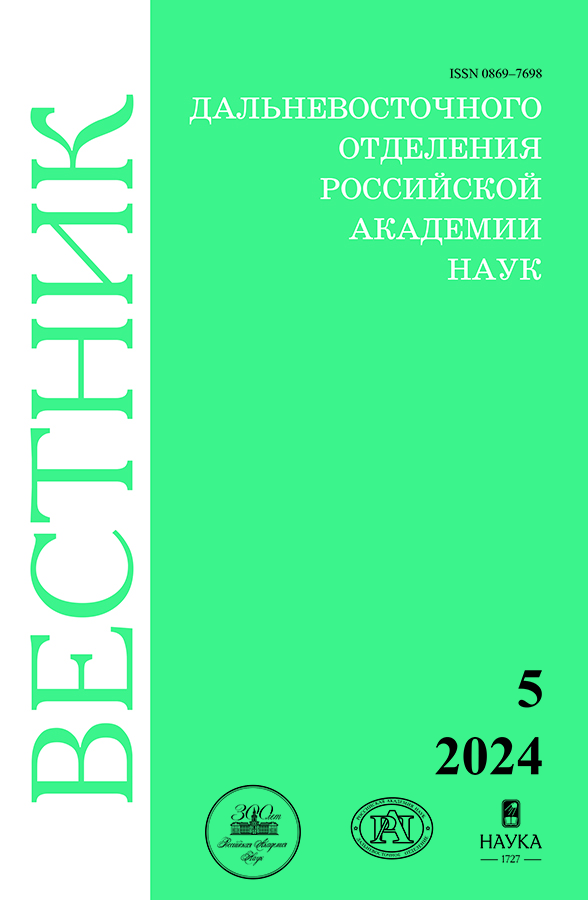Data interpretation of principal component and diatom analyses of Holocene sediments from Ptichye Lake (Southern Primorye)
- Authors: Elbakidze E.A.1, Romanova A.V.1
-
Affiliations:
- Far East Geological Institute, FEB RAS
- Issue: No 5 (2024)
- Pages: 124-135
- Section: Earth and Environment Sciences
- URL: https://archivog.com/0869-7698/article/view/685982
- DOI: https://doi.org/10.31857/S0869769824050086
- EDN: https://elibrary.ru/HPFCNW
- ID: 685982
Cite item
Full Text
Abstract
The diatom flora of the middle Holocene sediments from Ptichye Lake, located on the southern coast of Primorye, was studied through the principal component analysis to determine the main paleoeological factors affecting the species distribution. Multivariate analysis of the diatom taxa matrix enabled us to determine three principal components accounting for 78% of the variance, thus proving the analysis to be highly efficient. The first component explains the most variance (58%) and has high values associated with the Boreal neritic species of Actinoptychus senarius Ehrenberg (Ehrenberg). Comparing the results of diatom and principal component analyses, on the one hand, and lithological analysis, on the other hand, we identified the changes in diatom paleocommunities that occurred as transgression was being replaced by regression during the middle Holocene.
Keywords
Full Text
About the authors
Ekaterina A. Elbakidze
Far East Geological Institute, FEB RAS
Author for correspondence.
Email: ekato21@mail.ru
ORCID iD: 0009-0009-3241-4420
Junior Researcher
Russian Federation, VladivostokAlexandra V. Romanova
Far East Geological Institute, FEB RAS
Email: sandra_ru@bk.ru
ORCID iD: 0000-0003-2884-1197
Candidate of Sciences in Geology and Mineralogy, Senior Researcher
Russian Federation, VladivostokReferences
- Harper D. A.T. Numerical paleobiology. Computer-based modeling and analysis of Fossils and their distributions. New York; 1999. 468 p.
- Davis J. C. Statistics and Data Analysis in Geology. New York: John Wiley & Sons; 1986. P. 238–244
- Legendre P., Legendre L. Numerical Ecology. 2nd English Edition. Amsterdam: Elsevier; 1998. Vol. 24. 853 p.
- Xue J., Lee C. Using principal components analysis (PCA) with cluster analysis to study the organic geochemistry of sinking particles in the ocean. Organic Geochemistry. 2011;42(4):356–367.
- Gazley M. F., Collins K. S. Application of principal component analysis and cluster analysis to mineral exploration and mine geology. In: AusIMM New Zeal. Branch Annu. Conf. Dunedin; 2015. P. 131–139.
- Hammer Ø., Harper D. A.T. Past: Paleontological Statistics Software Package for Education and Data Analysis. Palaeontologia Electronica. 2001;4(1):1–9. URL: http://palaeo-electronica.org/2001_1/past/issue1_01.htm (date of access: 15.02.2024).
- Milan M., Albrecht N. et al. Clockwise hysteresis of diatoms in response to nutrient dynamics during eutrophication and recovery. Limnol. Oceanogr. 2022;6 (9):2088–2100.
- Edwards M., Beaugrand G. et al. Climate variability and multi-decadal diatom abundance in the Northeast Atlantic. France. P. 1–8. https://doi.org/10.1038/s43247-022-00492-9
- Chipman M. L., Clarke G. H. et al. A 2000 year record of climatic change at Ongoke Lake, southwest Alaska. USA; 2009. doi: 10.1007/s10933-008-9257-8.
- Evstigneeva T. A., Cherepanova M. V., Romanova A. V. Izmenenie okruzhayushchei sredy severo-zapadnogo sektora Yaponskogo morya v period poslednei deglyatsiatsii = [Environmental changes in the northwestern sector of the Sea of Japan during the last deglaciation]. Vestnik Severo-Vostochnogo Nauchnogo Tsentra DVO RAN. 2023;(3):3–17. (In Russ.).
- Jewson S. An alternative to PCA for estimating dominant patterns of climate variability and extremes, with application to U.S. and China seasonal rainfall. Atmosphere. 2020;11(4):354. https://doi.org/10.3390/atmos11040354
- Pushkar V. S., Cherepanova M. V. Diatomovye kompleksy i korrelyatsiya chetvertichnykh otlozhenii severo-zapadnoi chasti Tikhogo okeana = [Diatom assemblages and correlation of Quaternary sediments of the northwestern Pacific Ocean]. Vladivostok: Dalnauka; 2008. 174 p. (In Russ.).
- Pushkar V. S. Biostratigrafiya osadkov pozdnego antropogena yuga Dal’nego Vostoka (po dannym diatomovogo analiza) = [Biostratigraphy of sediments of the late Anthropocene in the south of the Far East (according to diatom analysis)]. Moscow: Science; 1979. 140 p. (In Russ.).
- Lozhkin A. V., Cherepanova M. V., Anderson P. M. Glukhoye Lake: Middle to Late Holocene environments of Kunashir Island (Kuril Archipelago, Russian Far East). Boreas. 2022;51(2):364–384. https://doi.org/10.1111/bor.12565
- Muranov A. P. Resursy poverkhnostnykh vod SSSR: Gidrologicheskaya izuchennost’ = [Surface water resources of the USSR: Hydrological Knowledge]. Leningrad: Gidrometeoizdat; 1970. Vol. 18, N2. 592 p. (In Russ.).
- Proshkina-Lavrenko A.I. Diatoms of the USSR (fossil and modern). L.: Nauka; 1974. Vol. 1. Practical guide. 403 p. (In Russ.).
- Mikishin Yu.A., Petrenko T. I., Gvozdeva I. G. et al. Golotsen poberezh’ya yugo-zapadnogo Primor’ya = [Holocene coast of southwestern Primorye]. Scientific Review. 2008;(1):8–27. (In Russ.).
- Guiry M. D., Guiry G. M. AlgaeBase. World-wide electron. publ. Nat. Univ. Ireland, Galway; 2021. URL: http://www.algaebase.org/search/species/ (date of access: 26.02.2024).
- Barinova S. S., Medvedeva L. A., Anisimova O. V. Bioraznoobrazie vodoroslei-indikatorov okruzhayushchei sredy = [Biodiversity of environmental indicator algae]. Pilies Studio; 2006. 498 p. (In Russ.).
- Diatom analysis. Opredelitel’ iskopaemykh i sovremennykh diatomovykh vodoroslei. = [Key to fossil and modern diatoms]. L.: Gosgeolitizdat; 1949. Vol. 2. 238 p. (In Russ.).
- Bertolli L. M., Talgatti D. M., Nascimento T. M.S., Torgan L. C. The genus Tryblionella W. Smith (Bacillariaceae, Bacillariophyta) in southern Brazil salt marshes. Biota Neotropica. 2020;20(1):1–18. e20190774. http://dx.doi.org/10.1590/1676-0611-BN-2019-0774
- Hasle G. R. Some Thalassiosira species with one central process (Bacillariophyceae). Norw. J. Bot. 1978;25(2):77–110.
- Cherepanova M. V., Lepskaya E. V., Anderson P., Lozhkin A. V. Issledovaniya vodnykh biologicheskikh resursov Kamchatki i Severo-zapadnoi chasti Tikhogo okeana. = [Diatoms from Holocene sediments of Lake. Nerpichye (Kamchatka)]. Research of Aquatic Biological Resources of Kamchatka and the North-Western Part of the Pacific Ocean. 2013;31:89–106. (In Russ.).
- Ol’shtynskaya A. P. Diatomei i kokkolitoforidy v golotsenovykh ehkosistemakh Prikerchenskogo sektora Chernogo morya. Ehkosistemy, ikh optimizatsiya i okhrana. Simferopol’ = [Diatoms and coccolithophores in Holocene ecosystems of the Kerchen sector of the Black Sea]. Simferopol: TNU; 2014. Vyp.11. S. 82–88. (In Russ.).
- Elbakidze E. A. Usloviya osadkonakopleniya ozera ptich’ego (Yuzhnoe Primor’e) v srednem golotsene po dannym diatomovogo analiza = [Sedimentation conditions of the bird lake (Southern Primorye) in the Middle Holocene according to diatom analysis]. In: Materials of the II youth scientific conference-school FEGI FEB RAS Geology on the outskirts of the continent. Vladivostok: FEFU Publishing House; 2022. 231 p. (In Russ.). DOI: https://doi.org/10.24866/7444-5330-5.
- Lutaenko K. A. Mollyuski iz golotsenovykh otlozhenii Khasanskogo raiona (Yuzhnoe Primor’e) = [Mollusks from Holocene deposits of the Khasan region (Southern Primorye)]. Stratigraphy. Geological Correlation. 1993;1(6):89–91. (In Russ.).
- Suto I., Kawamura K., Hagimoto S., Teraishi A., Tanaka Y. Changes in upwelling mechanisms drove the evolution of marine organisms. Palaeogeography, Palaeoclimatology, Palaeoecology. 2012;339–341:39–51.
- Lopes C., Mix A. C., Abrantes F. Diatoms is northeast Pacific surface sediments as paleoceanographic proxies. Marine Micropaleontology. 2006;60 (1):45–65.
- Zakharkov S. P., Lobanov V. B., Gordeichuk T. N., Morozova E. A., Shtraikhert E. A. Spatial variability of the chlorophyll a and the specific structure of the phytoplankton in the northwestern part of the Sea of Japan during the winter period. Oceanology. 2012;(3):354–363.
- Shevchenko O. G., Orlova T.Yu., Stonik I. V. Diatomovye vodorosli poryadka Chaetocerotales = [Diatoms of the order Chaetocerotales]. In: Adrianov A. V. (ed.). Biota rossiiskikh vod Yaponskogo morya. Vladivostok: Dal’nauka; 2014. Vol. 11. 247 p. (In Russ.).
- Korotkij A. M., Grebennikova T. A., Karaulova L. P., Belyanina N. I. Ozyornye transgressii v pozdnekajnozojskoj Ussuri-Hankajskoj depressii (Primor’ya) = [Lake transgressions in the Late Cenozoic Ussuri-Khanka depression (Primorye)]. Tihookeanskaya Geologiya. 2007;26(14):53–68. (In Russ.).
Supplementary files











